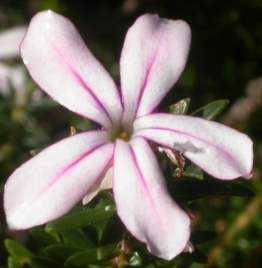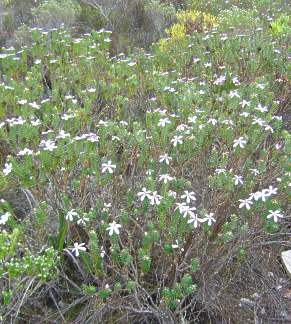Adenandra gummifera
Adenandra gummifera Strid
Family: Rutaceae
Common names: Potberg china flower, gummy china flower (Eng.); Potberg-porseleinblom (Afr.)
Introduction
A beautiful, aromatic, fynbos shrub with showy white porcelain-like flowers in winter and spring.

Description
Description
Adenandra gummifera is a single-stemmed, rounded bush and grows to a height of over 1 m. Older stems are light brown compared to the younger, pale yellow-brown stems. .Leaves are narrow to oblong, 8-14 x 2-3 mm, dull green, with a smooth upper surface and a prominent green mid-vein below. The oil glands present on the leaves, release a sweet aroma when touched or crushed.

Large white flowers are borne at the tips of branches and measure about 35 mm in diameter. Flowers are solitary or in groups of 1-4, sessile (lacking a stalk) to subsessile (almost stalkless). Petals are white on the inside and pinkish on the outside. The white petals have a very thin pink margin and a bright purple-pink nectar guide clearly visible in the centre of each petal. The sticky (glutinous) flowerheads become hard and tough when dry and remain on the bush during the next flowering season. Flowering period: June to October.

The fruit is a green, sticky capsule which darkens as it ripens, and consists of five compartments, each bearing one shiny black seed.
Conservation Status
Status
Adenandra gummifera is not listed as a threatened species, but is endemic, or restricted, to the Bredasdorp area.
Distribution and habitat
Distribution description
Adenandra gummifera grows naturally on the south-facing sandstone slopes of the Potberg in De Hoop Nature Reserve. It occurs at an altitude of 150 to 300 m. Adenandra gummifera grows naturally in sandstone rocks and in crevices on mountain slopes. It is also found growing in limestone proteiod fynbos.
Derivation of name and historical aspects
History
The genus name Adenandra is derived from the Greek, aden, meaning a gland, and ander, a man. The species name gummifera means producing gum. This gummy and sticky substance is produced in the flower heads.
The Rutaceae, known as the citrus family, has 14 genera. It includes several buchu genera such as Agathosma, Adenandra, Acmadenia, Coleonema, Diosm and Eucheatis, as well as tree genera such as Calodendrum and Vepris.
Ecology
Ecology
The showy white flowers attract pollinators such as bees, butterflies and other insects.
Uses
Use
Adenandra gummifera is best used as a garden plant and flowering stems can be used in floral arrangements. Dried leaves can be used in pot-pourri.

Growing Adenandra gummifera
Grow
Planting Adenandra gummifera in the garden is best done in the rainy seasons of autumn, winter and spring. Once established, they will withstand a fair amount of frost, and are capable of surviving long periods of drought especially during the summer.
Before planting, prepare the garden bed by digging over the soil, adding compost and a slow-release fertilizer, and water. . Plant buchus where they will receive full sun, in soil that is alkaline to acid, well drained and composted. Plant out in groups of 3 to 5 (20-30 cm apart) with enough space to encourage growth. Water well after planting. Plants require good watering in winter and moderate watering in summer. Do not allow plants to dry out and avoid cultivating the soil around the roots of these fynbos plants. They are slow-growing plants and should not be planted too close to fast-growing plants. A layer of mulch is added after planting and annually to keep soil and roots cool in summer, to retain soil moisture and to reduce weeds.
Adenandra gummifera is a water-wise plant and can be used as an accent plant or in a mixed fynbos bed with companion plants such as Mimetes cucullatus (rooistompie), Protea repens (sugarbush), Erica sessiliflora (green heath, Pelargonium cordifolium (heart-leaved pelargonium) and herbaceous perennials such as Lobelia valida, Geranium incanum , and Scabiosa incisa. Plant with other interesting buchu species such as Acmadenia obtusata, Adenandra obtusata (china flower), Agathosma collina and Coleonema album (white confetti bush).. This buchu is suitable for a rockery or used as a container plant.
Buchus can be successfully grown from seed or cuttings. Seed should be harvested when the seed capsule darkens and before the seed is dispersed. Seed ripens towards the middle of summer, during October to December. Seed collected from fully ripe capsules has a higher germination percentage. If seed is picked too early, the embryo will not ripen and the seed will not be viable. Fresh buchu seed is sown in autumn (March to April). The seeds are sown into a tray containing a well-drained medium of equal portions of sand, loam and compost. Use some of the medium to cover the seeds and water. Place in a covered area with good light and air circulation. Keep medium damp. Germination occurs in one to two months.
Young seedlings are pricked out into 0.5 l bags when four true leaves have developed, using a fynbos medium. Feed plants regularly but sparingly with a well-balanced fertilizer. Pinch out the growing tips of the seedlings to encourage bushy growth. Flowers are produced after two years.
After flowering, plants develop new shoots or branches, which are ideal for tip, stem or heel cuttings. Collect plant material early in the morning to reduce stress. Cuttings have the advantage of producing a larger flowering plant quicker than seedlings. Tip cuttings, 50-70 mm, are taken from the current year's growth. Prepare cuttings by making a clean cut below the node and remove a third of the foliage. Dip the base of the cutting in a rooting hormone such as Seradix 2. Firmly place the cuttings in a medium of 50% bark and 50% polystyrene and water cuttings with a fungicide. Ideally these cuttings should now be placed in an well-aerated propagation unit with a bottom heat of 24º C. Rooting occurs in 9 to 11 weeks. Carefully pot the rooted cuttings using a well-drained, humus-rich, fynbos potting medium (2 parts leaf mould, 1 part coarse sand). Plants will be ready for planting in 7 to 8 months, ideally during autumn to spring. Feed regularly with a well-balanced nutrient. Yellow leaves can be treated with an application of iron chelate.
References
- Gold, M. 1992 . The buchus: cultivation and propagation. National Botanical Institute, Kirstenbosch.
- Goldblatt, P. & Manning, J. 2000. Cape plants, A conspectus of the Cape flora of South Africa . Strelitzia 9. National Botanical Institute, Pretoria & Missouri Botanical Garden, Missouri.
- Mustart, P., Cowling, R. & Albertyn, J. 1997. Southern Overberg. South African Wild Flower Guide 8. Botanical Society of South Africa, Cape Town.
Credits
Norma Jodamus
Kirstenbosch National Botanical Garden
August 2006
Plant Attributes:
Plant Type: Shrub
SA Distribution: Western Cape
Soil type: Sandy
Flowering season: Spring
PH: Acid
Flower colour: White, Pink
Aspect: Full Sun
Gardening skill: Challenging
Special Features:
Horticultural zones







Rate this article
Article well written and informative
Rate this plant
Is this an interesting plant?
Login to add your Comment
Back to topNot registered yet? Click here to register.